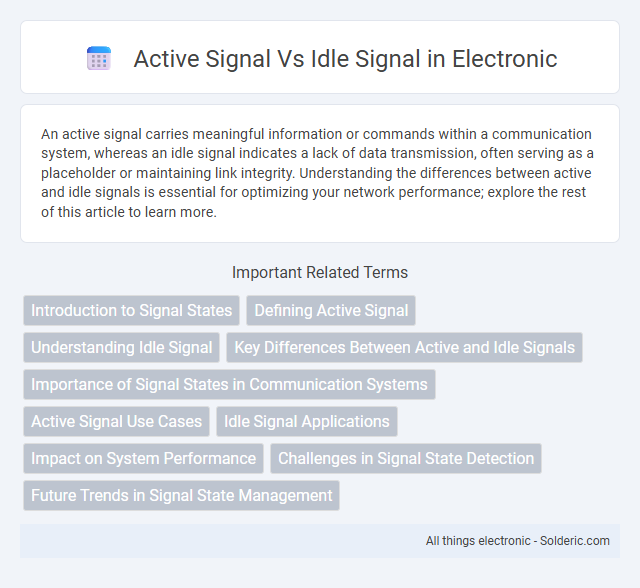An active signal carries meaningful information or commands within a communication system, whereas an idle signal indicates a lack of data transmission, often serving as a placeholder or maintaining link integrity. Understanding the differences between active and idle signals is essential for optimizing your network performance; explore the rest of this article to learn more.
Comparison Table
| Feature | Active Signal | Idle Signal |
|---|---|---|
| Definition | Signal transmitting data or carrying information | Signal in a waiting or inactive state |
| Purpose | Indicates ongoing communication or operation | Indicates no current data transmission |
| Energy Consumption | Higher power usage due to active processing | Lower power usage, conserves energy |
| Signal Strength | Typically strong and consistent | Minimal or baseline level |
| Examples | Data packets, voice signals during call | Standby signals, carrier waves without data |
Introduction to Signal States
Active signals represent an energized or operational state in electronic circuits, conveying meaningful data or instructions. Idle signals indicate a non-operational or standby state, maintaining circuit readiness without transmitting information. Distinguishing between active and idle signal states is critical for optimizing communication protocols and reducing power consumption in digital systems.
Defining Active Signal
An active signal refers to a distinct electrical or digital state indicating ongoing communication or data transmission within a system, signifying that a device or circuit is currently engaged in processing or transferring information. This contrasts with an idle signal, which represents a lack of activity or readiness without actual data exchange occurring. Understanding the characteristics of an active signal helps you optimize system performance by accurately detecting when components are operational or awaiting instructions.
Understanding Idle Signal
An idle signal represents a state with no active data transmission, maintaining a steady voltage level to indicate line readiness without interference. Unlike an active signal that conveys information through voltage or current variations, an idle signal ensures signal integrity by preventing false triggers during inactivity. Recognizing idle signals is essential for accurate timing and synchronization in digital communication systems.
Key Differences Between Active and Idle Signals
Active signals transmit data or commands by continuously sending electrical or digital pulses, ensuring real-time communication and system responsiveness. Idle signals, in contrast, represent a state of inactivity where no significant data or commands are being transmitted, often serving as placeholders or to maintain connection integrity. Understanding the key differences between active and idle signals helps you optimize communication protocols for efficiency and power management.
Importance of Signal States in Communication Systems
Signal states, specifically active and idle signals, play a crucial role in communication systems by defining the presence or absence of data transmission. Active signals indicate ongoing data flow, enabling synchronization, error detection, and efficient resource allocation, while idle signals signify periods of inactivity, helping to conserve power and reduce noise interference. Proper management of these signal states ensures reliable communication, optimal bandwidth utilization, and enhanced overall system performance.
Active Signal Use Cases
Active signals are critical in real-time communication systems, industrial automation, and sensor monitoring where immediate response and continuous data transmission are required. Your devices rely on active signals to maintain system integrity during processes like robotic control, emergency alerts, and live streaming, ensuring timely and accurate information flow. These use cases demonstrate the importance of active signals in maintaining operational efficiency and safety.
Idle Signal Applications
Idle signals are commonly used in telecommunications and digital communication systems to maintain synchronization and indicate the absence of active data transmission. In network protocols such as Ethernet or CAN bus, idle signals prevent line inactivity, reducing the risk of link failure and aiding in error detection. Embedded systems use idle signals to optimize power consumption by differentiating between active communication and standby modes.
Impact on System Performance
Active signals transmit real-time data that drives system responsiveness and ensures optimal performance by minimizing latency. Idle signals, while consuming minimal resources, can lead to reduced efficiency if the system remains in an unnecessary standby state for extended periods. Your system's overall speed and resource management directly depend on balancing active signal processing with effective idle signal handling.
Challenges in Signal State Detection
Detecting active versus idle signals poses challenges due to signal noise, interference, and varying signal strengths that can lead to false positives or missed detections. Advanced filtering techniques and adaptive thresholding are necessary to distinguish genuine active signals from background noise accurately. Your system's reliability depends on minimizing errors in signal state detection to ensure optimal communication performance.
Future Trends in Signal State Management
Future trends in signal state management emphasize dynamic switching between active and idle signals to enhance energy efficiency and reduce latency in communication systems. Adaptive algorithms leveraging machine learning optimize the detection and transition timing, supporting real-time applications such as IoT and 5G networks. Your network infrastructure will benefit from intelligent signal modulation that balances performance with power consumption by predicting activity patterns and minimizing unnecessary idle signal retention.
active signal vs idle signal Infographic

 solderic.com
solderic.com